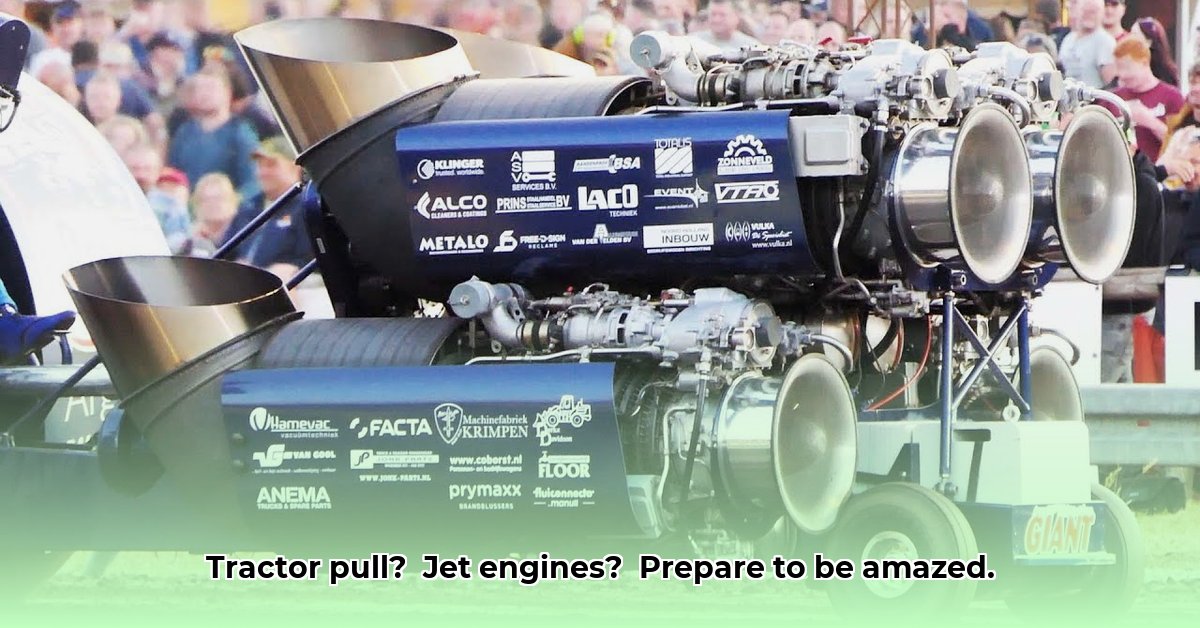
Forget your grandfather's slow-moving farm tractor. Jet engine tractor pulling is a mind-blowing motorsport where tractors, supercharged with the raw power of jet engines, tear across tracks in a spectacle of incredible power and daring engineering. This extreme sport pushes the boundaries of what's possible, blending incredible ingenuity with the very real possibility of spectacular, and potentially dangerous, failures. We'll delve into the engineering marvels, the human drama, and the inherent risks that define this unique competition. For more on traditional tractor pulls, check out this resource.
Adapting Aviation Power to Agricultural Might
Integrating a jet or radial aircraft engine into a tractor isn't a simple bolt-on – it's a complete reimagining of the machine. It's akin to fitting a rocket engine to a bicycle; the tractor's frame requires significant reinforcement to withstand the immense forces generated. This often involves using reinforced steel, custom-built components, and potentially carbon fiber for added strength and reduced weight.
But the challenges extend far beyond structural integrity. The transmission system needs a complete overhaul to efficiently channel the engine's tremendous power to the wheels. A custom-designed drivetrain is essential, far beyond anything found in a standard tractor. Weight distribution is critical; these engines are heavy, and an imbalance can lead to catastrophic results. Finally, precise control systems are paramount, allowing the driver to delicately manage the immense power while preventing uncontrolled launches or engine failures. How do you control such raw power? It's a question that defines the sport.
The Human Element: Daredevils and Their Metal Beasts
Competitors in jet engine tractor pulling are a unique breed: skilled operators who push both their machines and themselves to the limit. They are not just drivers; they are master engineers, constantly refining and modifying their creations. The stories surrounding tractors like the Radial Reactor, a prime example of both incredible power and the potential for failure, highlight the inherent risks and the courage these competitors display. What drives them? The thrill of the challenge, the desire to outdo their rivals, and the immense pride in creating these unbelievable machines.
Safety: A Necessary Consideration
The sheer power involved necessitates a paramount focus on safety. Catastrophic engine failure, snapped axles, and uncontrolled launches are very real possibilities. This isn't a spectator sport for the faint of heart; the risks extend to both the drivers and the spectators. However, ongoing efforts to improve safety include stricter regulations, better design practices, stronger materials, improved control systems, and rigorous testing. The goal remains to minimize risk while retaining the sport's thrilling nature. How can we balance spectacle with safety? It's a continuous challenge.
Reliability: The Constant Struggle
Reliability is a constant battle in this high-stakes game. These tractors are pushed far beyond their original design limitations. The immense stress on every component necessitates consistent maintenance and ongoing modifications. Unexpected breakdowns are a common occurrence. Research into stronger materials, advanced designs, and improved manufacturing techniques aims to improve reliability, but given the extreme conditions, it remains a continuous challenge.
Future Directions: Innovation and Evolution
The future of jet engine tractor pulling likely involves continuous innovation. We can anticipate lighter, stronger materials, more efficient engine technology, and advanced control systems enhancing both reliability and safety. Engineering firms play a vital role, providing specialized components and expertise. The quest for increased power and control will undoubtedly lead to creative solutions, pushing the boundaries of what's considered possible.
Stakeholder Actions: A Roadmap for the Future
The future of this sport relies on a collective effort. Competitors, engineering firms, regulatory bodies, and organizers all share responsibility for creating a safer and more thrilling environment. The table below outlines short-term (0-1 year) and long-term (3-5 years) goals for each stakeholder group, focusing on improving safety and fostering innovation.
| Stakeholder | Short-Term Goals (0-1 year) | Long-Term Goals (3-5 years) |
|---|---|---|
| Competitors | Enhanced safety training; Improved engine maintenance programs; Development of safer modifications | Advanced design and materials research; Exploration of alternative power sources; standardized safety modification protocols |
| Engineering Firms | Development of specialized components; Provision of design consultations; Safety technology advancements | Advanced control system development; More robust engine integration solutions; Research into safer propulsion systems |
| Regulatory Bodies | Enactment of stricter safety regulations; Increased event inspections; Improved accident investigation protocols | Standardization of safety testing; Development of clear liability frameworks; Increased funding for safety technology research |
| Spectators/Organizers | Implementation of improved safety measures; clear communication of risks to spectators; enhanced emergency response protocols | Enhanced spectator safety infrastructure; Improved participant training programs; development of better event management strategies |
Jet engine tractor pulling is a thrilling blend of immense power, human ingenuity, and calculated risk. The future of this extreme sport rests on ongoing development, continuous improvement, and a constant pursuit of pushing limits while ensuring the safety of all involved.